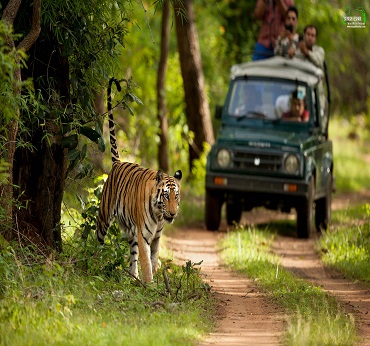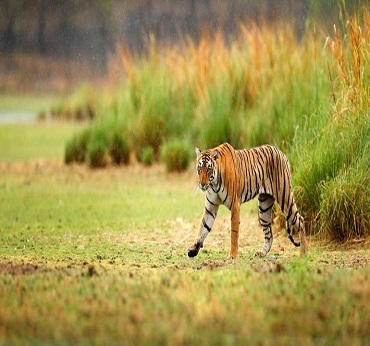Rajasthan Wildlife Tour
Overview
Rajasthan epitomizes all that dreams are made of. Think architectural memoirs built with studied detail, effervescent colors, stunning handicrafts, glittering gems, throbbing towns, wildlife sanctuaries, cattle fairs, or pulsating festivities and touching hospitality and you think Rajasthan. In this 10 days Rajasthan Wildlife Tour Package you will visit three famous wildlife sanctuaries in Rajasthan i.e. Sariska Tiger Reserve, Keoladeo National Park, and Ranthambore National Park. Embraced by the Aravalli ranges and cosseted from the desert sands, Rajasthan boasts of some picturesque locations. The wildlife sanctuaries in Rajasthan offer the best chance in India of spotting tigers and birdwatching.
Trip Highlights
Safari ride in Sariska National Park
Sightseeing tour of Jaipur- Amber Fort, City Palace, Hawa Mahal, and Jantar Mantar
Excursion to Ranthambore National Park
Jungle safari in the Ranthambore National Park
Bird viewing at Keoladeo Bird Sanctuary
Sightseeing tour of Agra- Taj Mahal, Agra Fort, and Itmad-Ud-Daulah’s Tomb
11 Days Rajasthan Wildlife Package Itinerary
Day 1: Delhi
Upon arrival at the airport, get transferred to the hotel. Later you may proceed for a sightseeing tour of Old Delhi which includes a light and sound show in Red Fort and Chandni Chowk, Rajghat. Overnight stay at the hotel.
Day 2: Delhi – Sariska
Today after breakfast, leave by road for Sariska Tiger Reserve from Delhi. Alwar is the access point for Sariska Tiger Reserve, a former maharaja hunting ground managed since 1979. The 881 sq. km. sanctuary encompasses acres of woodland which are home to abundant wildlife including sambar, chital, wild boar, nilgai, and other antelopes, jackals, mongooses, monkeys, peacocks, porcupines, and numerous birds. The park is also dotted with a number of evocative ruins and other man-made structures, including the old Kankwari Fort, and a Hanuman Temple deep within the park.
The other interesting monuments in Alwar are the beautiful Moosi Maharani ki Chhatri a majestic red sandstone and white marble cenotaph built in the memory of a mistress of Maharaja Bakhtawar Singh, a ruler of Alwar. You can also see the Vijay Mandir Palace and Moti Doongri. Stay overnight in the hotel.
Day 3: Sariska – Jaipur
Proceed for Jungle Safari in the morning. Return to the hotel and after breakfast leave by road to Jaipur. Upon arrival, check-in at the hotel followed by a leisurely tour of the city. Jaipur lives up to its reputation for beauty, charm, and the wonders of heritage without difficulty, for the most part, its enchanting bazaars wear 200 years on their sleeves with pride. Today, you will start your visit from City Palace it is a sprawling enclosure with numerous courtyards, gateways, gardens, and temples. It has one of the finest museums in the city with a display of costumes, weapons, miniatures, rare manuscripts, and other memorabilia. It houses painted walls and massive marble pillars, king’s collection of rare paintings and carpets. Later visit located just outside the City Palace, the Jantar Mantar or the Observatory of Sawai Jai Singh II has an extraordinary collection of complex astronomical instruments.
Then move towards, the famous Hawa Mahal which is the most widely recognized monument of Jaipur. All ornamentation is confined to the rear portion of this five-storey structure. The facade has overhanging windows with perforated screens, for the royal women to watch processions and other activities on the street below. Stay overnight in Jaipur.
Day 4: Jaipur
Today begins with an excursion to the Amber Fort, on the crest of a rocky hill 11 km north of Jaipur. The fort here was established in 1592 by Maharaja Man Singh and successive rulers added to the majestic structure until the 18th century. Of interest here is the stunning Diwan-i-Am, built of sandstone, the magnificent gate Ganesh Pol, Sukh Niwas, Jai Mahal, Jas Mandir, and Sheesh Mahal. In the evening, visit the Central Museum, it is a real colonial relic, from the Victorian-era decor to the mildewed exhibits themselves. The museum displays assorted Rajasthani ethnic groups and their cultures and has a good selection of 18th and 19th-century miniatures from the Mughal and Jaipur.
Next visit to the Birla Mandir, a flashy marble edifice built by the fabulously wealthy Birla family. The dazzlingly white exterior is embellished with fine carvings and the spacious interior and large stained –glass windows give the place a slightly churchy feel. Overnight stay at the hotel.
Day 5: Jaipur – Sawai Madhopur ( Ranthambore National Park)
Ranthambore National Park is reached via the small and rather grubby town of Sawai Madhopur. A combination of forest and scrubland in which nestle six lakes, the river Banas and its tributary Kandoli, make Ranthambore an ideal backdrop to see tigers stalking, hunting, playing with their young, or sunning themselves. In addition to tigers, Ranthambore is still home to very healthy populations of chital, nilgai, jackals, panthers, jungle cats, and a wide array of birds, among common peacocks and painted storks. One of the best places for bird watching is the Ranthambore Fort, which is also the site of a temple to Lord Ganesh. Entrance to the fort is free and it is open to visitors from dawn to dusk. Return to the hotel for an overnight stay.
Day 6: Ranthambore National Park
On the 6th day of the tour enjoy the morning jungle safari in the Ranthambore National Park. After breakfast proceeds to Bharatpur National Park by surface. On reaching Bharatpur, complete your check-in formalities at the hotel. Overnight stay in the hotel.
Day 8: Keoladeo Ghana Bird Sanctuary
To take in the essence of the Keoladeo National Park, you need to divide your trips into different times of the day. First experience the early morning birdlife and exquisite birdsong, take in spectacular sightings of large flocks of water birds in broad daylight or catch the elusive birds at dusk. Early in the morning sojourn into the park by 6:30 am, no motor vehicles are allowed inside and the most sensible options available are cycle rickshaws or bicycles.
Keoladeo’s 29 sq. km, including extensive areas of swamp and lake, have recorded about 375 species of birds with 150 odd migratory species from Tibet, China, Siberia, and Europe. The park is best known for its stupendous array of aquatic birds which includes saras crane, painted storks, spoonbills, pink flamingos, white ibis, and grey pelicans. There are also around 30 species of birds of prey, among them, vultures, marsh harriers, peregrine falcons, ospreys, and more colorful exotics including hoopoes, bulbuls, bee-eaters, and kingfishers. Overnight stay in the hotel.
Day 9: Bharatpur – Agra
In the morning, after breakfast, proceed towards Agra. Upon arrival in Agra, check-in at the hotel and relax for a while. Later, visit one of the world’s most famous and beautiful buildings, The Taj Mahal, which represents the unquestioned zenith of Mughal architecture. Overlooking the River Yamuna, The Taj Mahal stands at the northern end of vast gardens enclosed by walls. Then, move to Agra Fort, you must visit this massive complex for its magnificent architectural styles. Thereafter, head straight to Tomb of Itimad-ud-Daula, standing on the east bank of the Yamuna some 3 km north of Agra Fort. Later, return back to the hotel for overnight stay.
Day 10: Agra – Delhi
Post breakfast, leave for Delhi. On reaching Delhi, get transferred to the Delhi airport to board the flight for further journey.

Related Packages



Get in touch
Get in touch